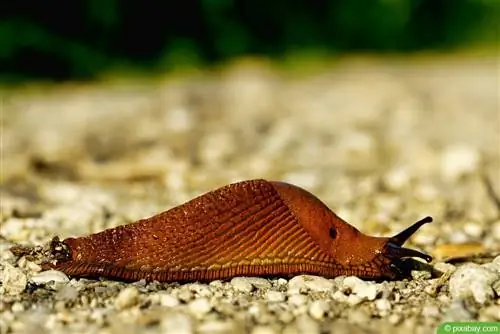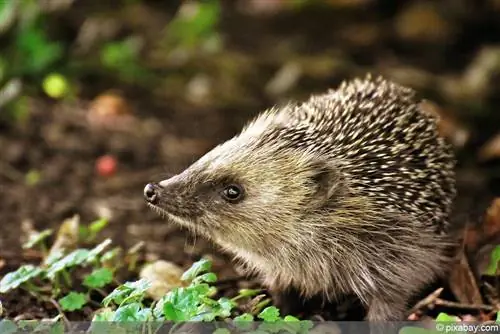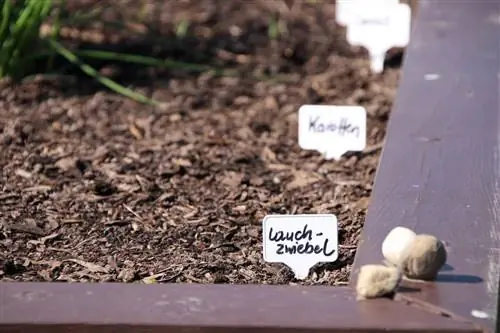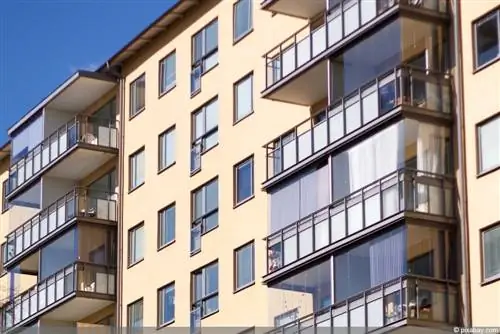- Author admin [email protected].
- Public 2023-12-17 03:39.
- Last modified 2025-01-24 12:45.
If entire plants disappear overnight, if leaves and flowers are found eaten or the fruits are hollowed out on the plant, snails are usually at work. The gardener can often even see traces of slime from the culprits or their grey-green snail droppings on the eaten plants. Shell snails cause little damage to the garden. In addition, some shell snails such as the Roman snail are protected and therefore cannot be controlled. Nudibranchs, such as the Arion or Deroceras species, are usually responsible for the damage to the leaves. The most common snail in the garden is the Spanish slug (Arion vulgaris).
Lifestyle
Snails consist largely of water (85%). However, they cannot actively influence their water balance themselves. That's why they prefer to be active in damp weather or at night. During the day or when it is dry, slugs hide in crevices, under stones or in dense (moist) stands of plants.
Propagation
Snails are hermaphrodites by nature, but all crawling snails are initially male. If two specimens of the same species meet, they exchange seeds with each other. Only now do both snails develop into female species and fertilize the eggs with seeds. 50-70 individual eggs are laid in regions where the eggs are protected from drying out. Depending on the snail species, several generations develop each year and can lay up to 400 eggs. Overwintering takes place as a snail or egg. But the snails are active again at temperatures of around 5 degrees.
Eating behavior
Snails can sense their food from a great distance because they can smell very well. The snails often find desirable plants the night after planting. The snails can also migrate from gardens that are further away, because although they appear to be very slow, they can still cover a distance of around 25 m overnight.
Snail control

Of course, no gardener likes it when the plants they have grown with great effort are quickly razed to the ground by snails. One or two snails may still be manageable, but a whole snail plague cannot simply be tolerated. There are different methods to tackle the problem. A combination of several control methods works best.
Prevent new immigration
The snails migrate from moist areas such as meadows or hedges to the beds in the garden. In these cases, immigration can be prevented or severely restricted by a strip of water-absorbing or sharp-edged material at the border. The snails need a lot of mucus to overcome the barrier. These protective strips must be spread along the entire property boundary (or bed boundary) to a width of approximately 2 cm.
Suitable materials:
- Sawdust (very fine)
- Sand (sharp edges like quartz sand)
- Brightlime
- broken eggshells
- Primitive rock flour
- sharp-edged mulch
In wet weather, however, these protective strips quickly become ineffective and must be replaced. So-called snail fences have therefore proven to be effective in combating snails. Snail fences are curved sheets of metal that are pressed into the ground around the area to be protected - without any gaps. At the beginning it is necessary to catch all snails inside the cordoned off area.
Encourage natural enemies

There are a whole range of natural enemies for snails. To combat snails, it therefore makes sense to provide these animals with appropriate protection and suitable habitats.
- Hedgehogs: piles of brushwood, hedgehog caves
- Birds: Nesting Opportunities
- predatory beetles: insect hotels, old trunks, rotten wood, piles of leaves or brushwood
Collect by hand
The snails are usually out at night or on wet days. That's why it's possible to go hunting at dusk armed with a flashlight and collect them from the plants. However, in this case, gardeners are faced with the question of what to do with the collected snails.
- cut through
- freeze
- pour boiling water over it
- feed to chickens or ducks
If you don't want to kill the snails, you have to release them again at a sufficient distance. In this case, the neighbor's garden is not enough, because then the snails will be back in no time.
Tip:
If you lay out wooden boards, old bricks or an old plastic bag and keep the ground underneath moist, you can avoid night-time searches, because the snails use these areas for their daytime roost and can easily be collected there.
Setting up snail traps
Although snail traps can be bought at any garden center for a few euros, they are not necessary. Every gardener can easily build effective snail traps using simple means. For a garden of around 100 m², around 20 snail traps are necessary. That means around two hours of effort, but it brings a lot.
- Lay a black foil (or board) on the beds in the spring before planting and place vegetable waste underneath it
- place cut peppers or hollowed tomatoes in a damp, shady place
- Place upturned flower pots over vegetable waste
- Insert the beer bottle or glass two thirds deep into the bottom and fill it with a little beer; Beer traps work best in combination with a snail fence
Preventive ground measures
Even with targeted soil care, a snail infestation in the garden can be greatly reduced. From autumn onwards the beds will no longer be worked on. During this time, the snails lay eggs again, from which the next generation will hatch next spring, starting in February. Snails lay their eggs in cavities in the ground to protect them from frost. The gardener can break this cycle by working the soil several times in winter with a rake (cultivator). The snail eggs are brought to the surface and freeze, dry up or are eaten by animals.
Nematodes
The use of nematodes is a very effective and environmentally friendly (although expensive) way to combat snails. For example, Phasmarhabditis hermaphrodita can be used on snails. The nematodes are tiny roundworms that penetrate the snails and kill them within a week. Nematodes are cultivated by special beneficial insect companies and delivered as granules to be dissolved in water. The nematode liquid is then poured onto the bed. However, the product does not work optimally against the Spanish slug and therefore has to be applied several times every few weeks.
Liverwort extract
An animal-friendly and environmentally friendly measure against a snail plague is spraying the plants with a mixture of liverwort extract and water. Snails avoid plants treated in this way even if no other food source is available to them. In the course of their development, mosses have developed defenses against mold and bacteria, and liverwort also develops defenses against snails. The dosage is “according to feeling”. Almost no manufacturer gives exact dosage recommendations for the product, but overdosing on liverwort is almost impossible. It's best to start with a small amount and increase the dosage as needed. Liverwort extract must be used early and regularly. For an initial orientation, around 5 ml of extract can be added to one liter of water and sprayed onto the plants every week or two weeks.
Chemical control

Chemical remedies against snails are usually on the market in pressed form, so-called slug pellets. Snail pellets can contain different active ingredients that kill snails. Most of these poisons work when taken orally, but there are also contact poisons that are absorbed through the mucous membranes. Poisons should always be used as a last resort when nothing else works. Because if other animals eat the poisoned snails, they can also die. Many of these poisons also have harmful effects on humans. Anyone who uses slug pellets in the garden should do so in a very controlled manner. It is best not to apply the slug pellets to the garden soil, but to deposit them in gap traps.
- Methiocarb (trade name “Mesurol”): neurotoxin that can harm not only snails but also many other animals; The drug causes respiratory paralysis in humans
- Methaldehyde: removes water from the snails and thereby kills them (can be fatal to children if ingested)
- Iron(III) phosphate (“Ferramol”): most biologically compatible substance; Snails that have eaten iron (III) phosphate retreat and die a few days later because their water balance is disturbed
Conclusion
Promoting beneficial insects, collecting them, snail fences or even snail traps should generally contain the snail plague to such an extent that chemical agents are no longer necessary or are only necessary to a very limited extent. Snail control should always be started very early, especially after a mild winter. It's best when the outside temperature exceeds 10 degrees. In these cases, large snail infestations cannot even form.
Tips for speed readers
- Slugs are usually responsible for damage to plants
- they are nocturnal and prefer a moist, shady shelter during the day
- Nudibranchs lay up to 400 eggs
- Start fighting very early (February)
- Restrict immigration through a barrier made of sharp-edged materials around the beds
- create optimal conditions for predators
- Lay out foil, upturned flower pots or wooden boards
- collect snails during the day
- Use snail traps
- Apply nematodes against snails
- Spray liverwort extract on the plants
- rake the garden soil several times in winter (brings the snail eggs to the surface)
- Use chemical agents only in exceptional cases
- It's best to use several methods at the same time






